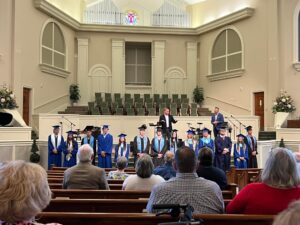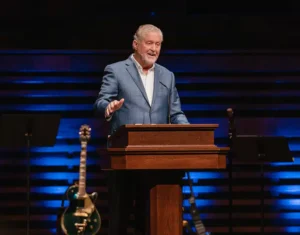

Some of the thirty volunteers needed each weekday to package and distribute food through Heaven’s Windows, the nonprofit based at New Seasons Church in Spring Valley, California. Photos by Angie Kretschmar.
Southern Baptist churches of various sizes and in various settings are feeding the hungry in the United States.
And a sizable number of Americans remain in need of such help. Almost fifty million Americans, or nearly one in six, live in “food insecure households,” according to Feeding America, a nationwide network of two hundred food banks.
Local Church Ministries
Many people turn to churches in their need. More than two in ten Americans (22 percent) say their family has received help from a church-run food pantry, LifeWay Research reported in November.
Southern Baptists staff and stock thousands of local church and community-wide faith-based hunger ministries across the nation. Some have in-house food pantries. Some cooperate with community food banks. Some work with local ministries or agencies. Some provide after-school meals. Some place food in school children’s backpacks for the weekend. Some assist with community gardens.
Global Hunger Relief
In addition, the Southern Baptist Convention created a fund, Global Hunger Relief (GHR), through which Baptists (and others) can contribute to hunger needs in North America and around the world. Gifts to GHR annually fund numerous hunger projects, with 80 percent going to overseas hunger needs, administered through the International Mission Board, and 20 percent going to North American hunger needs, administered through the North American Mission Board (NAMB). Because of Southern Baptists’ giving through the Cooperative Program, 100 percent of GHR funds help relieve hunger, with none used for administrative costs.
Last year, more than one thousand ministries in North America—mostly local churches with active food ministries—received hunger funds through NAMB.
Meeting hunger needs opens doors for volunteers to proclaim the Good News of salvation in Jesus Christ. Russell Moore, president of the Ethics and Religious Liberty Commission, has encouraged Southern Baptists to participate in GHR “not simply as an act of charity, not simply as an expression of our love, certainly not as a bare humanitarianism, but because we are a Gospel people who as we feed and as we clothe are speaking and preaching a message that Jesus is Himself the Bread of Life.”
Whether receiving funds through NAMB or not, Southern Baptist churches are feeding the hungry. Here is a look at how three churches help relieve hunger in their communities:
New Seasons Church

Some of the eighty elementary-age children from a nearby school who receive snacks daily through Heaven’s Windows at New Seasons Church.
New Seasons Church in Spring Valley, California, uses a nonprofit ministry on its property to distribute tens of thousands of meals each year to people in its poor neighborhood eleven miles east of San Diego.
The multi-ethnic church, which averages about seven hundred in attendance, was already running an active food ministry when it established the non-profit, Heaven’s Windows, in 2009. Its outreach to the hungry consists of:
- A five-day-a-week food pantry that served more than twelve thousand households in 2014.
- A monthly community distribution that provided food for about five thousand households last year.
- A child nutrition program at thirteen sites after school and during the summer. About eighty students from a nearby elementary school receive snacks daily at the church. New Seasons Church in El Cajon feeds about 125 children a day. Heaven’s Windows served nearly seventy-five thousand meals or snacks to children last year.
- A hot meal each Wednesday for community residents, many who are homeless. About 2,500 were fed last year in this outreach.
- A hot meal that is delivered each Thursday to the homebound and disabled. More than two thousand such meals were provided in 2014.
- A block party—known as Season of Love—on the Saturday before Thanksgiving that welcomed 3,600 guests last year and gave away seven hundred turkeys and twenty thousand pounds of food.
New Seasons Church, which is about 50 percent African American at its two campuses, provides funding for Heaven’s Windows, which also receives donations and grants, said Angie Kretschmar, the ministry’s executive director. The food pantry receives many items from two San Diego food banks through a federal government program, as well as fresh produce, milk, eggs, and bread donated by such retailers as Walmart, Big Lots, and Sprouts Farmers Market.
Of the people whom Heaven’s Windows serves, some “aren’t saved; they don’t know any churches,” she told SBC LIFE. “When they go through a crisis, they’ll remember that church, and that opens a door for ministry.
“I can make you a long list of volunteers I have now that came to volunteer [before they were saved and joined the church],” Kretschmar said. “They got baptized. [They’re] in church. [They’re] in ministry.”
A. B. Vines, New Seasons’s senior pastor, said the hunger ministry builds “a bridge to the community.”
“Once [people] see the love of Christ is real and there’s no gimmick,” they are receptive to hearing the Gospel, said Vines, former president of the SBC’s National African American Fellowship.

The food pantry at Heaven’s Windows served more than twelve thousand households in 2014.
Trace Creek Baptist Church
Trace Creek Baptist Church in New Johnsonville, Tennessee, ministers to the needy in a town of fewer than two thousand people about a ninety-minute drive west of Nashville.
Trace Creek, which averages about one hundred fifty in Sunday worship, helps with the county’s church-run food pantry and stands ready to provide food when the pantry cannot, said pastor Mark Warren.
The church also cooperates in a weekend backpack ministry with four other churches. The combined effort provides snacks and other food items for students whom teachers have identified as likely having a need for nutrition. The backpack ministry serves about sixty elementary and junior high students, Warren estimated.
The church’s Wednesday night AWANA ministry also has resulted in feeding needy children. A significant portion of the eighty to ninety children who participate in AWANA during the school year are unchurched, Warren told SBC LIFE. After learning some children arrived at AWANA without eating dinner, the church now feeds about seventy children each Wednesday evening.
Hunger ministry is “an obedience thing more than anything, because there’s probably not a lot of fanfare with it. . . . [Y]ou don’t want to bring embarrassment to people through it,” Warren said.
A note goes to families whose children are part of the backpack ministry to inform them churches are cooperating to provide the food. “So naturally, to those families who are affected, it shows we care and aren’t just about getting you into our building,” he said. “We want to be obedient to need.”
The Summit Church
The Summit Church in the Raleigh-Durham, North Carolina, area primarily meets hunger needs as part of its multi-pronged outreach approach. The church has many members it can mobilize—attendance at its eight campuses averages around eight thousand each weekend.
While the church’s benevolence pastors help with emergency food needs, The Summit’s five outreach initiatives—the homeless, orphans, prisoners, unwed mothers, and disconnected youth—focus on relationship-building that enables those who are receiving ministry to recognize what God is like.
“The church is God’s demonstration community,” said Matt Mig, The Summit’s pastor of local outreach. “So He’s putting on display His feeling, His desire for them, and His character through how our people act.”
The Summit tends to feed the hungry and do other ministry “through the infrastructure or framework” of organizations that excel in meeting needs, he told SBC LIFE.
For instance, providing meals happens through the work of Summit teams at homeless shelters in both Durham and Chapel Hill. Some of the ministry to disconnected youth involves providing food in backpacks.
“The local schools will organize it and say they need help doing it,” Mig said. “We get our teams out there and help them pull it off.”
This kind of relational approach to ministry, Mig said, can be a “first step” for many, who ask: “How am I going to go outside my comfort zone right here where I already live and intentionally engage someone whose path I wouldn’t have otherwise crossed, unless I was pursuing them, because the Gospel changed my life?”
How to Start a Hunger Ministry
Preparation is vital for churches that want to launch a hunger ministry, say those with expertise in feeding the needy.
“It’s a lot more than just handing out food,” says Angie Kretschmar, executive director of a thriving ministry to the hungry based at a Southern Baptist church in San Diego County.
Here are some recommendations gleaned from the North American Mission Board (NAMB) and Kretschmar for congregations considering hunger ministry:
- Recognize the need. This includes discovering which churches and organizations already are feeding the hungry. A cooperative effort with others may be best. “The key is commitment to serve others in the name of Jesus,” according to NAMB.
- Find the food. Locate the sources of food for the ministry. Check out food banks. Investigate the availability of surplus food, possibly from supermarkets or government agencies. Determine how much food can be provided through the church.
- Identify the volunteers. Discover how many people are able to serve. A hunger ministry requires a “very, very reliable volunteer base,” says Kretschmar.
- Select a ministry. Decide what kind of hunger ministry the church should initiate. It might be food pantry distribution, after-school feeding, weekend backpacks for students, or another approach. Some choices require a place for storage and a plan for distribution.
- Plan for the Gospel. Resolve what the practice will be in sharing the Good News of Jesus.
NAMB’s steps for starting a hunger ministry are available at www.namb.net/beginning-a-hunger-ministry.
It’s possible, however, that God may drop a hunger ministry on a church. That’s what happened to Trinity Church, a church plant in Portland, Oregon.
Trinity’s planter/pastor, Clay Holcomb, was visiting one day in the office of the elementary school that would be home to the church’s worship services. School officials were discussing Backpack Buddies, a program to provide meals for needy children, but were uncertain who would conduct it, since the school could not.
“We hadn’t even had our first service yet, and I said, ‘Well, we’ll do it,’” Holcomb recalls in a NAMB video. He is NAMB’s SEND city coordinator for Portland.
Trinity provided food for the backpack ministry for three years, serving 100 to 125 students in that time.
“The ministry helped build into our church a vision for the community,” Holcomb told SBC LIFE, “and it helped us build credibility in the eyes of the people involved in the school.”















